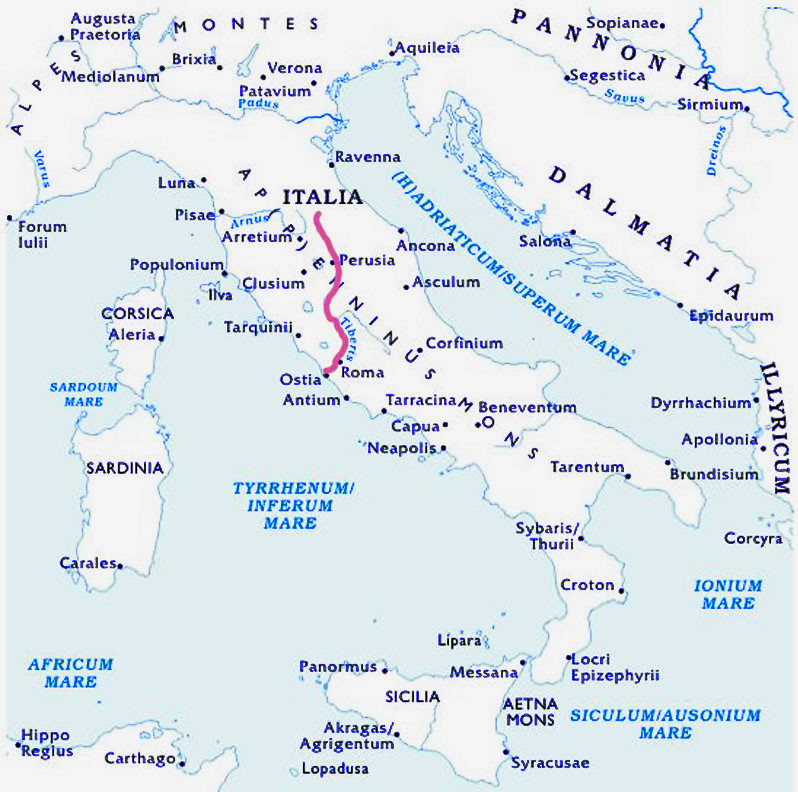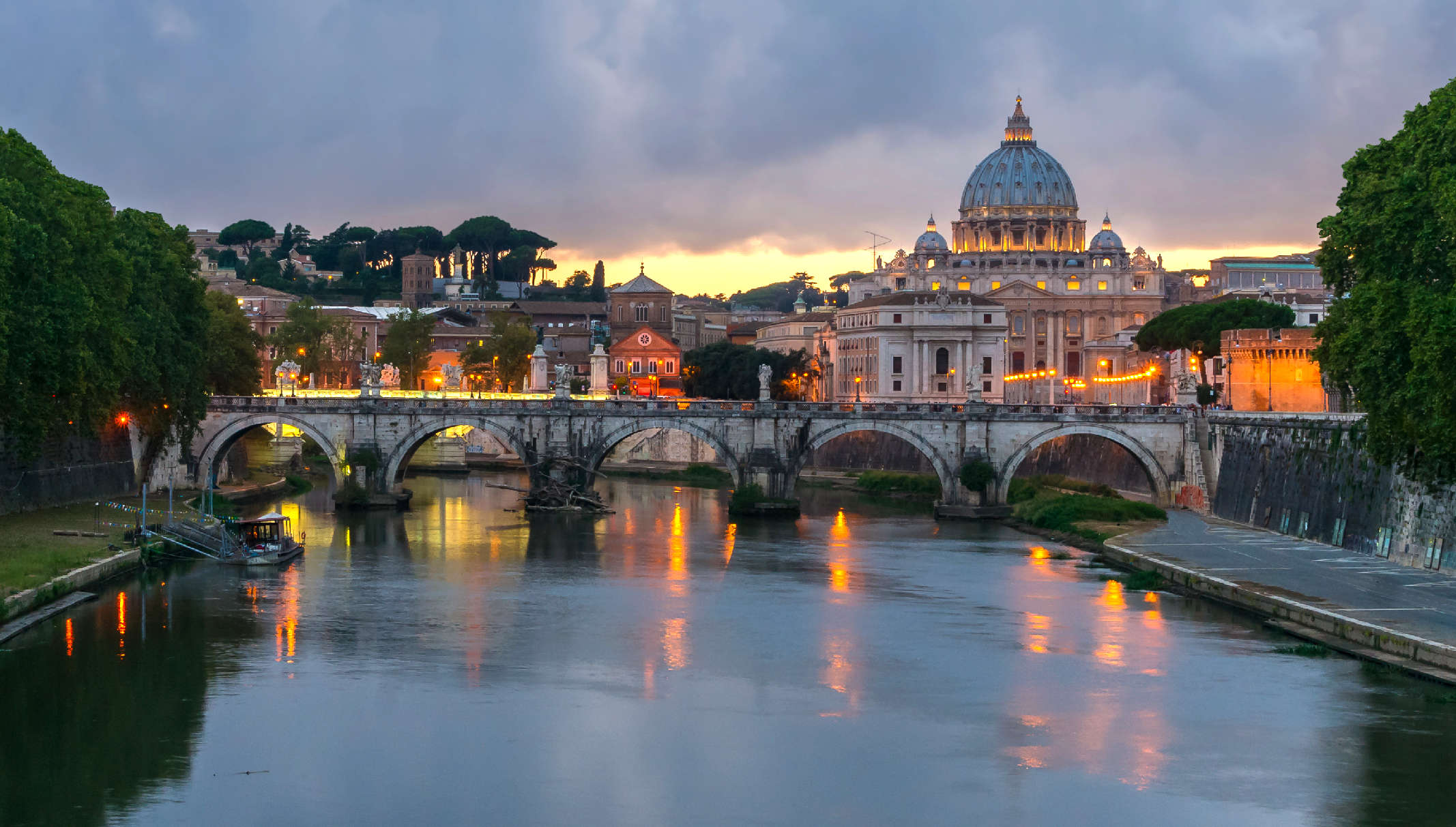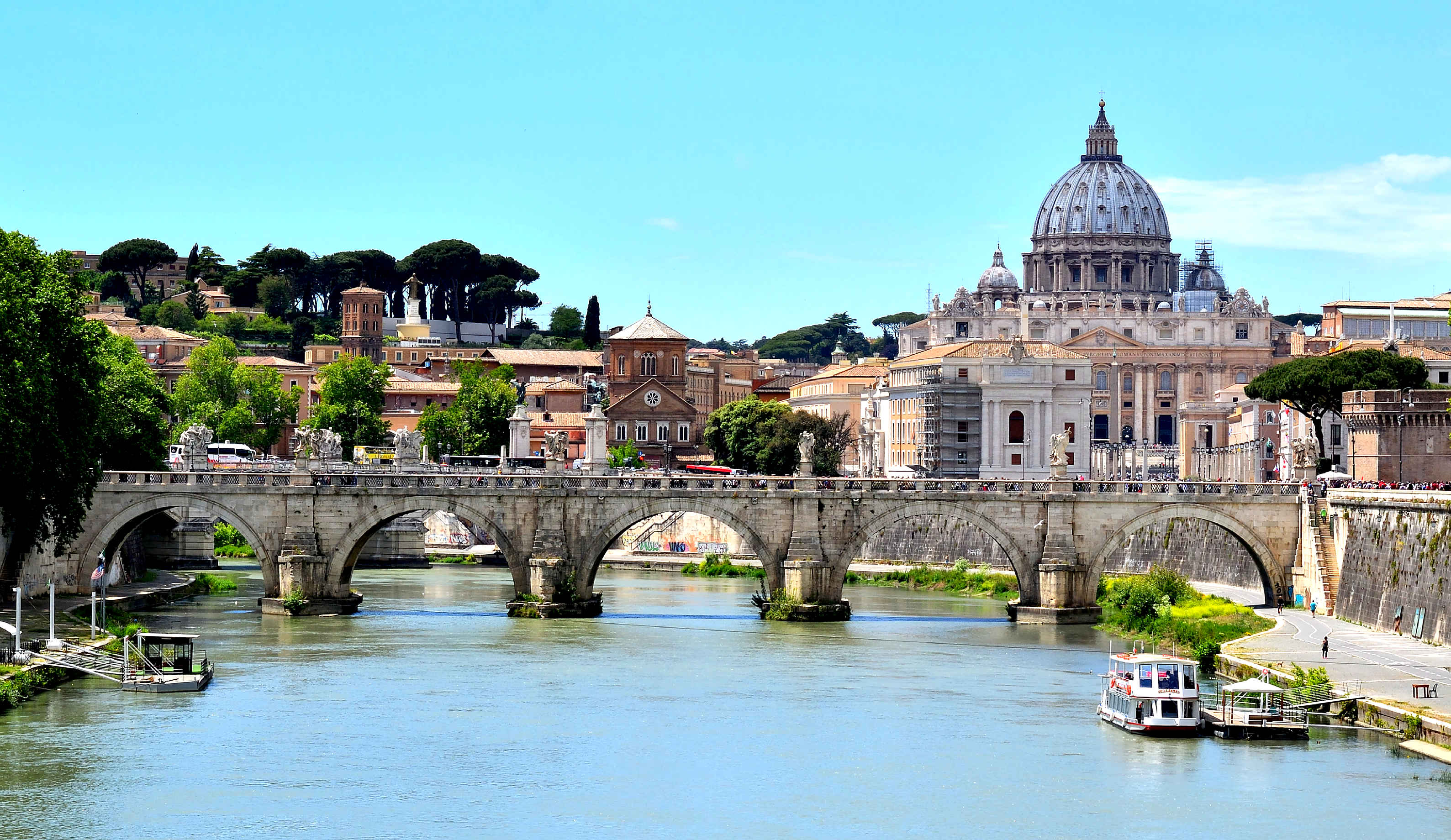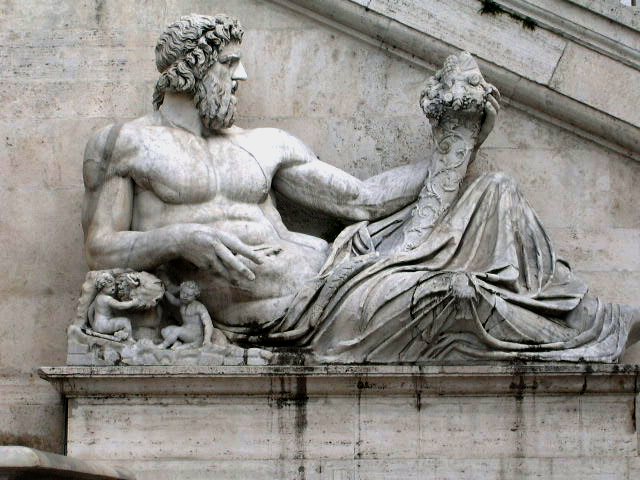|

The
River Tiberis, Italy
The Tiber, or Tiberis, is a historic river of Europe and the second longest Italian river after the
Po, rising on the slope of Monte Fumaiolo, a major summit of the Appennino Tosco-Emiliano. It is 252 mi (405 km) long. Twisting in a generally southerly direction through a series of scenic gorges and broad valleys, the Tiber flows through the city of Rome and enters the
Tyrrhenian Sea of the
Mediterranean near Ostia Antica. Its major tributaries are the Chiascio, Nestore, Paglia, Nera, and Aniene. Below Rome, the Tiber branches out into a delta, the main channel being the Fiumara, with the Fiumicino functioning as a distributary branch on the north side. Some ancient writers allege that it was known originally as Albula - a reference to the whiteness of its
waters - but it was renamed Tiberis after Tiberinus, a king of Alba Longa (an area centred on Lago Albano, south of Rome) who was drowned in it.
The importance of the Lower Tiber was first recognized in the 3rd century BC, when Ostia was made a naval base during the Punic Wars. It later became a commercial centre for the import of
Mediterranean wheat, oil, and wine. Successive attempts to maintain Ostia, on the Fiumara, and the port of the emperors Claudius and Trajan, on the Fiumicino, were defeated by the processes of silting and by the deposition of sandbars at the river mouths. In later centuries, several popes tried to improve navigation on the Lower Tiber, and ports were built at Rome in 1692, 1703, and 1744. Navigation and trade upon the Lower Tiber flourished again between the late 18th and mid-19th centuries, when further dredging took place on the lower course. Silting continued, however, with such persistence that, within another century, the Tiber was only navigable at Rome itself. The Tiber Delta, meanwhile, had advanced about two miles seaward since Roman times. (Concise Britannica Online.)
The Romans made some effort to control the river's lower course, but their ignorance of hydraulic principles prevented the development of adequate protection against floods. It is only in modern times that the Tiber has flowed through Rome between high stone embankments. Though the river varies in depth between 7 and 20 ft, there is some evidence that navigation upstream to the Val Tiberina was significant for the grain trade as long ago as the 5th century BC. Later, the shipment of building stone and also of timber became important. In its zenith, classical Rome was supplied with vegetables grown in the gardens of riverside villas.
The Tiber is the third-longest river in Italy and the longest in Central Italy, rising in the Apennine Mountains in Emilia-Romagna and flowing 406 km (252 mi) through Tuscany, Umbria, and Lazio, where it is joined by the River Aniene, to the
Tyrrhenian
Sea, between Ostia and Fiumicino. It drains a basin estimated at 17,375 km2 (6,709 sq mi). The river has achieved lasting fame as the main watercourse of the city of Rome, which was founded on its eastern banks.
The river rises at Mount Fumaiolo in central Italy and flows in a generally southerly direction past Perugia and Rome to meet the sea at Ostia. Known in ancient times (in Latin) as flavus ("the blond"), in reference to the yellowish colour of its
water, the Tiber has advanced significantly at its mouth, by about 3 km (2 mi), since Roman times, leaving the ancient port of Ostia Antica 6 kilometres (4 miles) inland.

TWENTY-SIX
BRIDGES
The left and right banks of the Tiber connect 26 bridges on the territory of Rome. Along with the new bridges, a few of the old ones have successfully survived. For example, the Milvian Bridge (Italian: Ponte Molle or Ponte Milvio) was founded in the 1st century BC to prolong the Via Flaminia (an ancient Roman road) and to connect Rome with Ariminum (modern Rimini). In the 4th century AD, the Milvian Bridge was a place for a tremendous battle between two emperors, Maxentius and Constantine the Great (Latin: Constantinus).
Ponte Sisto is a pedestrian bridge crossing between the right bank of the Tiber and Trastevere. The medieval stone bridge, dedicated to Pope Sixtus IV, looks very beautiful in the background of the old quay. On the left bank, right across the bridge, is Piazza Trulissa – a popular meeting place for residents of the capital and visitors of Trastevere. From July to August, the Tiber at Ponte Sisto quay is filled up with tents with snacks, cocktails, and live music. Everybody is invited to look at local prices and plunge into the cozy atmosphere of the evening.
To the south of Vatican City, on the river, there is a small island – Isola Tiberina, which looks like a fishing boat from a bird’s-eye view. In the 10th century, The Basilica of St. Bartholomew on the Island (Italian: Basilica di San Bartolomeo all’Isola), where the tomb of San Bartolomeo is, was founded. If you cross the Tiber across the island, then, on the right bank, one of the most amazing Roman sights – the Mouth of Truth (Italian: Bocca della Verita) – can be seen.
Ponte Sant’Angelo (meaning the Bridge of Hadrian) dates back to the 2nd century AD. It is used only for a walk. In ancient times, the bridge was named after Emperor Hadrian, because it was built under his command. The crossing leads to the Mausoleum of Hadrian, also known from the Middle Ages as Castel Sant’Angelo. The castle’s huge stone cylinder keeps the Christian pontiffs’ remains and many historical artifacts. In the 15-16th centuries, the bridge, faced with marble, was decorated with statues of Saints Peter and Paul. And in the 17th century, Giovanni Lorenzo Bernini completed the decor with 10 statues of angels.
HISTORY
According to legend, the city of Rome was founded in 753 BC on the banks of the Tiber about 25 km (16 mi) from the sea at Ostia. Tiber Island, in the center of the river between Trastevere and the ancient city center, was the site of an important ancient ford and was later bridged. Legend says Rome's founders, the twin brothers Romulus and Remus, were abandoned on its waters, where they were rescued by the she-wolf, Lupa.
The river marked the boundary between the lands of the Etruscans to the west, the Sabines to the east and the Latins to the south. Benito Mussolini, born in Romagna, adjusted the boundary between Tuscany and Emilia-Romagna, so that the springs of the Tiber would lie in Romagna.
The Tiber was critically important to Roman trade and commerce, as ships could reach as far as 100 km (60 mi) upriver; some evidence indicates that it was used to ship grain from the Val Teverina as long ago as the fifth century BC. It was later used to ship stone, timber, and foodstuffs to Rome.
Several popes attempted to improve navigation on the Tiber in the 17th and 18th centuries, with extensive dredging continuing into the 19th century. Trade was boosted for a while, but by the 20th century, silting had resulted in the river only being navigable as far as Rome.
The Tiber was once known for its floods — the Campus Martius is a flood plain and would regularly flood to a depth of 2 m (6 ft 7 in). The river is now confined between high stone embankments, which were begun in 1876. Within the city, the riverbanks are lined by boulevards known as lungoteveri, streets "along the Tiber".
Because the river is identified with Rome, the terms "swimming the Tiber" or "crossing the Tiber" have come to be the shorthand term for converting to Roman Catholicism. A Catholic who converts to Protestantism, in particular Anglicanism, is referred to as "swimming the
Thames" or "crossing the Thames".
In ancient Rome, executed criminals were thrown into the Tiber. People executed at the Gemonian stairs were thrown in the Tiber during the later part of the reign of the emperor Tiberius. This practice continued over the centuries. For example, the corpse of Pope Formosus was thrown into the Tiber after the infamous Cadaver Synod held in 897.
FIVE
INTERESTING FACTS
1. The Tiber flows out of two mountain springs, located at an altitude of 1268 meters (4160,1 ft) above sea level. In 1930, Benito Mussolini established the ancient marble column at the river’s source. The Latin words “Here is born the river / sacred to the destinies of Rome” are engraved on the obelisk.
2. One of the river’s features is regular flooding. Thus, the Campus Martius area is often used to plunge underwater up to 2 meters (6, 6 ft). However, Romans have been reasonably safe since 1876, when the city authorities built high stone fences on both banks of the Tiber.
3. Another interesting fact is associated with the river’s name: a set expression “to cross the Tiber” means to become a Catholic convert. Analogously, “to cross the Thames” means to be converted into Anglicism. In times of religious war, such idioms were of great importance.
4. In ancient Roman times, public execution was carried out by drowning criminals in the Tiber. In the reign of Tiberius, convicts were taken to Scale Gemonie and then pushed into the deep water. Such an unenviable fate could occur to ordinary robbers and the first
Christian
pontiffs.
5. The Romans love to revive themselves by swimming in cold water. So on the 1st of January, courageous, even desperate residents of the capital, accompanied by the rollicking hooting of the crowd, jump from Ponte Cavour into the Tiber!

NAVIGATING
THE TIBER - DEVIN ROSE
Devin Rose takes readers on a guided conversation with one of your Protestant friends that serves as an aid in the sometimes contentious debates that can occur. The books title is
Navigating the Tiber: How to Help Your Friends and Family Journey Toward the Catholic Faith.
First an explanation of the title. Often times the conversion process is referred to as “crossing the Tiber.”
Devin Rose crossed the river in 2001. The reason is Rome sits along the Tiber river. So in essence, conversion is a symbolic crossing from the opposite side of the Tiber over to the Rome side of the Tiber. The process isn’t always easy and is often filled with inner struggles when trying to accept some Catholic teachings, and must include some welcoming friends to help guide one in the journey.
You can be those friends and this book will be your guide. There is a right way and a wrong way to go about this. We must remember that the transition one goes through when leaving Protestantism to Catholicism is not easy. It takes a gentle hand and an understanding heart to lead your friends and family to the Catholic faith and Devin gives us the tools to do so. “Before we begin, understand that it is not enough just to learn apologetics and lay them on your friends. Much more is required, beginning at the human level with friendship. If you are not first and foremost a friend, then no amount of brilliant apologetics will help you.”
One area I personally found interesting and useful was The first chapter that gives a complete breakdown of the vast oceans of beliefs that are out there. Take a quick poll of your friends and you will easily see that this is true. Evangelical, Baptist, Pentecostal, Calvinist, Lutheran, United Church of Christ, Methodist, and the list goes on and on. Heading into conversation on religious beliefs is a lot easier when one knows where their friend is coming from and this chapter does an exceptional job providing a brief synopsis of each.
Upon setting the experience, providing assurances that one can successfully help a friend convert, and giving tips to avoid a downward spiral into conflict; Devin launches into the real meat and potatoes of the book. He covers a myriad of potential topics that may arise. The book is divided into three parts.
Part 1: Setting Sail covers issues like the canon of scripture, sola scriptura (the belief in the Bible alone and no tradition), apostolic succession, and sola fide (justification through faith alone).
Part 2: Making Headway tackles some deeper issues such as perspicuity as championed by Martin Luther, introducing the Church Fathers (an absolute favorite topic of mine, to know the Church Fathers is to cease to be Protestant), and understanding the influence of the Reformers on your friends’ beliefs.
Part 3: Surviving the Rapids brings you into the homestretch with some of the most difficult Catholic viewpoints including the papacy, the importance of Mary, the Crusades as well as contraception and divorce.
You’ve spent months and perhaps years planting the seeds and watering them. If you have successfully laid out the truths of the Catholic faith you will be bringing the ship into harbor. Your friend has navigated the waters of the Tiber and though at some points the water was rough they have set anchor on the opposite shore and are ready to disembark for Rome. If you have made it this far than the end is near and, hopefully, you will be soon welcoming your friend into the Catholic Church with open arms. We can thank Devin Rose for your success and the gift he has given the Church with this book. Praise be to God!
JOHN
STORM
In
this fictional series, our hero is strongly opposed to all
forms of pollution. Including social and political. He is a
conservationist first, and an activist second. Leading by
example. John
Storm captains a zero
emission solar
and hydrogen
powered ship called the Elizabeth
Swann.
He
eats a healthy diet, and prefers to drive electric
vehicles, whenever possible. He owns an electric
Jeep, that
he converted himself. Though, it can run on methanol,
using the original 4.0 liter petrol powered, internal
combustion engine.
Following
a request by (the fictional) Pope
Peter Benedict, for a consultation with John, he is
tasked with navigating the Tiber in the Elizabeth
Swann, such as to moor conveniently to the Vatican
Palace. Only to find that is not as easy as Google maps
make it appear, and that there is little information on the
subject. Mainly because of the narrowness of some of the
ancient Roman bridges, with stone arch spans, not conducive
to wide multi-hulled vessels. But then of course, how many
people would want to travel upriver in a large boat. It was
a rather unusual request, necessary only inasmuch as the
Swann is a mobile floating laboratory.

REFERENCE
https://
|



